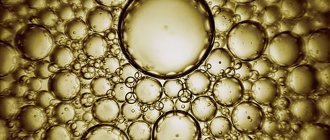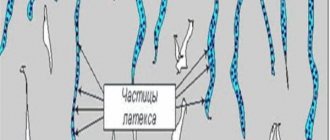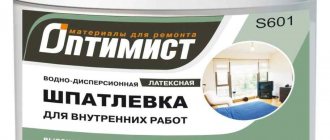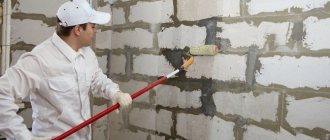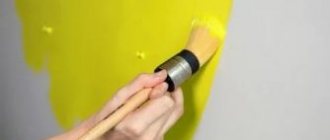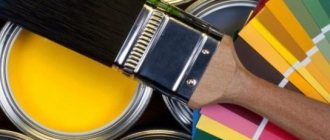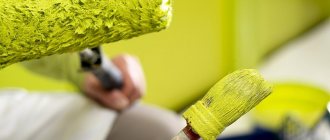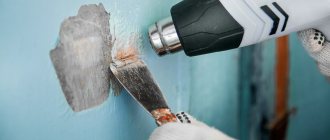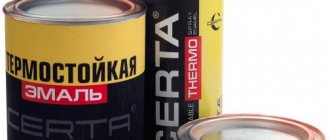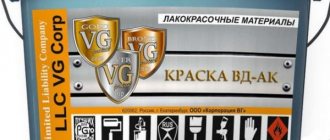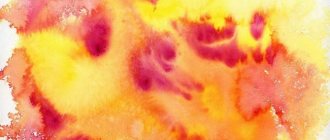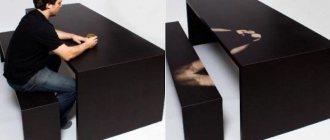Acrylic VDK for external use
To organize work outdoors, you must wait for favorable weather conditions.
When applying a layer of acrylic VDK, it is important to follow the following rules:
- High humidity levels contribute to the destruction of the coating. After application, a protective layer will not appear, so the paint will not be able to dry completely.
- Work is not carried out in windy weather. There is a possibility of sand or small debris sticking to it.
- Exposure to direct sunlight will cause paint to set unevenly. During hot periods, it is recommended to create artificial shading. It will be easier for the master to work, defects during application can be avoided, and drips can be removed.
Acrylic paint must be applied according to the instructions.
Sequence of work:
After cleaning, the facade must be primed with a specialized deep penetration compound.
- First, remove all stains and dirt from the surface. It is recommended to use a degreaser.
- All irregularities are leveled out. You can use putty, cement-sand mortar, and plastering the walls.
- Areas with mold are treated with rags and removed with sandpaper. A fungicide is applied to problem areas.
- When painting for the first time, the walls are pre-primed with a roller or brush. The primer dries within 14 hours.
- The paint is thoroughly mixed before use. You can give the desired shade by adding color or mixing several pigments.
After hardening, the layer of material becomes durable and cannot be washed off. For personal safety, wear gloves or treat the skin with a thick cream.
What it is?
Water-dispersion paint is a multi-component mixture for painting surfaces made of different materials. A characteristic feature of such paints is that water serves as a diluent for coloring substances.
Dispersion paints may contain a different number of components, but the basis is the following:
- substances that form a polymer film on the surface and bind all components (polymers: styrene, acrylic, latex);
- pigment substances, thanks to which the desired color is obtained;
- synthetic or natural fillers that impart the basic properties of the coloring composition (minerals: talc, calcite, mica, chalk, marble powder);
- special technological additives to improve the texture and storage of the mixture. The addition of ethylene glycol helps impart frost resistance. The composition includes preservatives, antiseptics, emulsifiers and thickeners.
Water-based paint is sold in the form of a paste of varying consistency. To obtain the coloring mixture, add clean cold water in the amount necessary for application to the area to be painted with a roller, brush or spray gun. As it dries, the added water evaporates from the surface, resulting in the formation of a stable protective film.
Calculation depending on the type of material
The most important parameter that must be taken into account when calculating the required paint composition for facade work is the type of paint. The paint and varnish material is selected depending on the characteristics of your facade. In this case, the consumption for each type will be individual.
Water-based paint
The basis for water-based paint is water, which contains an insoluble emulsion in the form of pigment. After applying such a composition to any surface, the water evaporates and only the pigment base remains in the form of a colored layer.
If you decide to purchase a composition of this type, then you should know that for facade work it is applied in two layers. The time interval between painting two layers should be more than one and a half hours.
Advantages:
- resistance to frost;
- low water permeability;
- lack of response to exposure to ultraviolet rays;
- acceptable cost.
The calculation in this case should be based on the fact that about 300 grams of the composition are usually consumed per 1 m2 of the surface of the facade walls. That is, if you need to paint 10 m2 of facade, you will need to purchase at least 3 liters of paint and varnish material.
Acrylic paint
Facade acrylic paint retains color well over time
Acrylic-based paints and varnishes are an ideal option for facade work. Advantages of acrylic painting:
- duration of preservation of the bright color and protective properties of the coating;
- resistance to aggressive atmospheric factors such as high humidity, wind or direct sunlight;
- ease of maintenance, for which ordinary detergents are sufficient;
- fire safety;
- absolute safety for human health;
- versatility that allows you to process any façade surface, from brick or concrete to solid wood.
As a rule, the consumption of acrylic paint is less than water-based paint. Typically it ranges from 150 to 200 grams per 1 m2. A more accurate consumption of façade paint per 1 m2 depends on how bright you want the painted coating to be. You can finally decide only by directly applying the composition to the surface.
If you get the required shade in one or two layers, then per 1 m2 you will need approximately 130-170 grams. If you need to obtain a more saturated color, you will have to count on 200 grams per 1 m2.
Oil-based paints and varnishes
Oil paint consumption depends on the desired color brightness
The oil composition consists of drying oil, color pigments and various fillers. At the same time, fillers can be sold both as part of the paint and in the form of separate solutions. If you are dealing with thickly grated oil compositions, you will have to dilute them a little before applying.
Calculating the consumption of oil paint, like acrylic paint, also depends on the desired brightness of the color. For example, if you apply a small amount of red composition to the surface of façade walls, it will look pink. The standard consumption for painting on plaster is usually 150 grams per 1 m2 and can vary depending on the required color.
Alkyd paint
Alkyd paint and varnish material is based on alkyd resins, which are used in production. Its peculiarity is that for facade work the composition must be diluted with turpentine, kerosene or drying oil. When diluted, each of these components will have an individual consumption of material per 1 m2 of surface to be painted. Therefore, in order to more accurately calculate consumption, you should take into account the number of additional mixtures that are used to obtain a brighter shade.
Traditionally, the consumption of façade paint per 1 m2 of wall surface is small and amounts to about 100 grams. That is, for 10 m2 you will need to spend only a liter of paint. A distinctive feature of the alkyd composition is the creation of a stylish and original appearance. In addition, such paint will protect the facade surface from the appearance of fungi and mold.
All about the product
Specifications
Manufacturer's logo
- When applying the composition to the surface according to TU BY 500021625.090-2007, the color should be green, dark steel, dark blue, dark brown, dark red, old red and red. Deviations are allowed only within the limits established by control color samples.
- The appearance of the coating after its application should be uniform, without corrosion, pores and wrinkles.
- According to the VZ-246 viscometer with a nozzle 4 mm in diameter at a temperature of 20⁰C±0.5⁰C, the conditional viscosity should be equal to 20. In this case, the degree of grinding is at least 20 µm.
- The pH of the paint is from 8 to 10, and the mass of non-volatile substances is about 54%. At temperatures from 40⁰C to 50⁰C, the third degree drying time is no more than 10 minutes.
- Adhesion for VD-AK-133-1 is not less than 1 MPa. The covering power of the composition after drying is no more than 80g/m2. At temperatures from 18⁰C to 22⁰C, the film’s resistance to static water is at least 24 hours. Color fastness no more than 3∆.
Other options
You can apply the primer with a paint roller
To apply this primer paint to the surface, you can use a brush or a paint roller (preferably made of mohair or wool) at the initial viscosity of the composition. But the instructions also allow you to do this with a spray bottle, only in this case it should be diluted with water to a viscosity of 18-20 (data from the VZ-246 viscometer) and use a nozzle diameter on the spray gun of 4 mm.
At temperatures from 18⁰C to 22⁰C, the primer is applied in two layers with an hour break, while the consumption of acrylic paint VD-AK-133-1 ranges from 180 g/m2 to 210 g/m2 (the manufacturer provides a six-month guarantee from the date of manufacture of the product).
In industry, this primer is used for protective and decorative painting of asbestos-cement slate sheets, which are heated to a temperature of 40⁰C to 50⁰C, but if you do it yourself at home, you can paint the slate with a brush, but the temperature should not be lower than 15⁰C.
This paint is also used for exterior finishing (gables, facades) and for interior coatings in rooms with high humidity (kitchen, bathroom). Practice has shown that wallpaper adheres well to walls coated with VD-AK-133-1, as excellent conditions for adhesion are created.
Also, the technical characteristics of the acrylic primer VD-AK-133-1 make the coating neutral to the formation and activity of microorganisms, that is, there is no breeding ground for organic colonies such as moss, mold, algae, lichens and rot.
The weather resistance of the paint is expressed in its resistance to temperature changes, precipitation and ultraviolet radiation (does not fade from sunlight), in addition, the material in any state (liquid or dried) does not pose a fire risk.
Insulated van
Transportation and storage of the VD-AK-133-1 primer is carried out at a temperature of at least 5⁰C, that is, negative temperatures during transportation and storage are absolutely unacceptable, although frost is not particularly important for performance. So in winter, storage is carried out exclusively in heated warehouses, and transportation is carried out in insulated trucks and cars.
Painting works
In the photo - grouting plaster
Before applying a primer to the surface, you should make sure that the rough base is suitable, that is, it must be solid (without loose areas) and there must be no cracks on it. In addition, there should be no grease stains, old paint, lime or wallpaper glue (if it is interior decoration), since all these factors significantly reduce the adhesion properties.
In cases where the plaster or putty is fresh, you should wait until it is completely dry, and if for rotbands and putties this period lasts a maximum of a week, then for cement-sand plasters this period is 28 days.
Mixing paint
Before starting painting work, VD-AK-133-1 must be thoroughly mixed, for which you can use the most ordinary wooden stick or a piece of thick wire, but if the volume is large, then this should be done with a mixer clamped into an electric drill (the mixer is specially for paint).
In addition, you should pay attention to the weather conditions if everything happens outside - the air temperature is allowed to be at least 15⁰C, without any precipitation (rain, hail, fog, strong wind). Before use (after stirring), the composition is filtered through a 0.1-0.2 mesh (GOST 6513)
How to calculate
In order to determine the consumption of water-based paint per 1 m² in two layers, there is a calculator. And also all actions can be performed manually. First of all, you should decide which surfaces will be painted and how many layers are expected to be completed. Knowing the geometric dimensions of the room, calculate its area. If it is a wall, you need to remove the area of windows and doors.
Consumption of different types of paint Source otdelkasten.com
Let's assume that the total painting area is 30 m². From the technical specifications it is known that 1 liter is consumed per 10.5 m² of area. We determine that in 1 layer for painting you will need:
30 m² : 10.5 m² x 1 liter = 2.86 liters
Accordingly, two layers will take 5.72 liters. Based on the specific gravity of 1.35 kg per liter, we obtain the required mass:
1.35 kg x 5.72 liters = 7.72 kg
round up and get 8 kg of paint. It is important to remember that to be on the safe side, it is better to increase the data by 5–10%.
Properties and features of both types
In order to determine what water-based and water-dispersion paints are, as well as how they differ, it is necessary to consider several important factors:
- their constituent components;
- specific gravity;
- viscosity;
- consumption;
- application features;
- expiration dates.
Water-based emulsions
First of all, let's get acquainted with water-based paint and its main characteristics. This type of coating contains water with particles of special polymers and pigments. Sometimes mineral, acrylic or silicone resins may also be contained. The viscosity of such paint can be changed by adding a special solvent in varying quantities.
The average consumption of water-based paint is about 210 ml of product per 1 sq.m of painted area. However, this indicator may vary depending on the type of surface, degree of dilution and some other factors. The specific gravity of this type of coating, as a rule, is no more than 1.5 kg.
Important advantages characteristic of this type of paint are:
- high level of environmental safety;
- absolute absence of odor when the coating dries;
- ease and ease of application;
- convenient color change by tinting;
- wide selection of application tools;
- favorable and affordable price.
Today, there are several types of water-based paint, each of which has its own unique properties:
- mineral;
- acrylic;
- silicone;
- silicate.
They all differ from each other both in composition and scope of application. The most budget option is mineral water-based coatings. They are usually based on cement or slaked lime. Such coatings are used for painting many types of surfaces, but they cannot boast a long service life.
The most popular universal option is acrylic water-based emulsion. It is ideal for coating plaster, wood, brick and concrete surfaces, as well as glass and metal.
The most expensive coating is a silicone water-based coating, which is based on high-quality silicone resins. Any type of surface can be coated with this paint.
For rooms with high levels of humidity, it is recommended to use silicate water emulsions, which contain liquid glass, as well as coloring pigments.
Water dispersants
Now let's move on to water-dispersion paints. These coatings are based on aqueous dispersions, as well as acrylic, latex or polyvinyl acetate binders. In this regard, the scope of paint, as well as its strength and moisture-resistant properties, differ.
The simplest and most inexpensive option is water-dispersion paint based on PVA - polyvinyl acetate. In most cases, it is used for painting ceilings in various rooms. It is highly undesirable to use it in the bathroom and kitchen due to its low moisture resistance. Another significant drawback of this type of paint is its tendency to get dirty quite quickly.
The second type is latex water dispersion. The coating it creates is more durable and resistant. In addition, it is absolutely not afraid of dirt or water.
And finally, the third type of paint is acrylic water dispersion. Thanks to its high protective properties and ideal resistance to adverse weather conditions, it is ideal for use both inside and outside buildings of various types. It can be applied to concrete and wooden surfaces of walls and ceilings. High humidity does not threaten such a coating at all.
Types of water-dispersed paints based on basics
On sale you can find several types of water-dispersion compositions that will have different bases. Each option has its own specific advantages and disadvantages that must be taken into account. Next, we will consider the most popular paints of this type and their features.
Based on PVA
The most popular and at the same time financially affordable option is a water-dispersion solution. To make the material, polyvinyl acetate or “white” glue is used. Such a coating can retain its original color for a long time and does not fade when exposed to direct sunlight. But if the weather is humid, the paint layer will quickly begin to fall off or crack. This material also does not tolerate various types of contamination. This cheap option can only be used in dry rooms where there is not too much light.
Acrylate
Water-dispersed acrylic compositions are very popular among specialists. Most often, this material is used for exterior work or for finishing walls and ceilings indoors. The main advantages of the material include the following:
- Long service life. If the coating was applied to a properly prepared substrate and is of high quality, it can last up to 15 years.
- The composition contains no components harmful to human health.
- The material does not have any unpleasant odor.
- The composition tolerates moisture well and can be washed if necessary.
- After complete drying, a vapor-permeable film is formed on the surface, which protects the base from the formation of mold and mildew in the future.
- The product has a fairly high adhesion rate, so it can be used to treat a wide variety of substrates, including concrete or wood.
- The composition is completely fireproof and will not ignite.
- The use of this paint is very simple, so even those people who have never done repair work before can cope with the work.
- The coating dries incredibly quickly and at the same time is able to eliminate small cracks, strengthens the surface and protects it from a variety of mechanical damage.
When using this type of paint indoors, you should make sure that there are no drafts. In the case of external work, there are several more factors that can affect the final result and they must be taken into account in order for the repair to be high-quality and durable.
Latex or styrene butadiene
Styrene-butadiene dispersions are excellent for interior work.
They have a high moisture resistance and are therefore suitable for use in bathrooms or kitchens. The finished coating does not require special care and will not wear off over time. A huge advantage of the material is that it has a high elasticity rate and is able to eliminate minor cracks on the treated surface. Latex-based paints can only be used indoors. If the material is exposed to ultraviolet radiation, it will soon begin to turn yellow. Also, such paints do not tolerate low temperatures, so they cannot be used for outdoor work.
Working with VDK
The use of interior water-dispersion paints is available even to a person without experience in finishing work.
Tools
- paint roller,
- telescopic handle to the roller for those who prefer to work while standing on the floor;
- a tray (cuvette) with a ribbed platform for removing excess material from the roller;
- wide brush for painting corners and joints;
- a narrow brush for painting hard-to-reach places and areas that require special care (around sockets and switches, for example);
- masking tape is useful for protecting baseboards if they have not been previously dismantled, and borders with other areas that cannot be painted.
Interesting: masking tape can be used when painting one wall in different colors. This design technique is called zoning and allows you to conditionally divide the space in a room into several parts, different in functional purpose: a work area (computer desk and office chair), a rest area (sofa and TV), and so on.
Preparing for painting
Water-dispersion paint forms a thin film on the surface, which, although it covers small cracks, is still unable to smooth out all the flaws and irregularities. In order for the walls or ceiling to look perfect after finishing, they will have to be properly prepared.
- When the surface is in good condition, that is, the old coating lies flat or is completely absent, you just need to wash it with soap and dry it. If there is a problem in the form of peeling old paint, chips, deep cracks, more serious intervention will be required: the unusable layer of material is cleaned off with a spatula or scraper; in particularly difficult cases, use a drill with a special attachment.
- The cleaned surface is treated with a vacuum cleaner and leveled with starting putty, and after it dries, with finishing putty. All roughness is rubbed down with sandpaper. Clean from dust again.
- A smooth, clean and dry wall must be primed to achieve maximum strong adhesion of the paint to the surface. It’s good if the primer contains antiseptics, this guarantees protection against putrefactive bacteria and fungi.
Coloring
First of all, the coloring composition needs to be mixed. A construction mixer or drill with an appropriate attachment is suitable for this.
Paint is applied to the corners with a wide brush, and border areas and difficult areas are painted with a narrow brush. Now you can pour the solution into the cuvette and start working with the roller properly, soaking it and freeing it of excess liquid to avoid drips.
Walls are always painted from above, the roller is rolled in vertical and horizontal directions alternately, gradually moving to the very bottom of the wall.
To paint the ceiling, it is important to know: no matter how many layers are placed on the surface, the last of them must be applied perpendicular to the wall with the window, that is, to the natural light source. If you take this nuance into account, the ceiling will look most advantageous; dark stripes and spots will not appear on it
Rating of facade paints
Facade paint differs from interior paint in its elasticity and does not crack due to temperature changes. When choosing a finish, it is recommended to ensure that it is resistant to mechanical and chemical influences, ultraviolet radiation, moisture, etc. To paint the facade the following is used:
- Akrial. The enamel has a certificate of conformity, so it is used for outdoor work. The composition is used for finishing brick walls. The dye is resistant to temperature changes. It allows moisture to pass through from inside the room and prevents it from penetrating the walls from the outside. The composition is resistant to solar radiation and does not change its appearance for 5-10 years.
- VGT. This is a facade enamel that is applied to wooden, plastered and brick walls. Once the vgt dries, there is a matte sheen to an even finish. The composition is resistant to precipitation and ultraviolet radiation. White paint creates a breathable layer. It is applied by spray, brush or roller.
- Caparol. A silicone-based composition is made and used to cover plastered walls. Enameling with silicate or dispersion dyes of the matte type is allowed. The special material has covering power and is resistant to aggressive environmental influences. The composition can be diluted with water. After its application, no film is created on the surface.
- Parade. This is an elastic-crack-resistant composition that is resistant to aggressive atmospheric influences. Enamel retains its properties at temperatures down to -20 degrees, so it is used for finishing facades in temperate climates. The silicone composition is moisture-proof and resistant to ultraviolet rays.
- Vdak. This is a suspension with filler and pigments, the basis of which is a synthetic acrylic polymer. Enamel is characterized by weather resistance, moisture resistance, and wear resistance. When precipitation falls on the painted surface, splashes and swelling do not remain. It is used for the facade of the temple and other structures erected from scaffolding. Primer is first applied to the surface.
- Pufas. This is a dispersion enamel, which is used for cost-effective painting of surfaces. Characterized by resistance to frost and atmospheric influences. To preserve the properties of the enamel, a primer is first applied. Available in white. To add shade, energy crystal color gmf w001 tinting pastes are used.
- Enamel ko 174. Organosilicon enamel is used for painting metal products to protect them from corrosion. Retains its properties in the temperature range -60-+150 degrees. Facades made of brick, concrete, asbestos cement, reinforced concrete, and plastered surfaces are painted with enamel. The enamel can be tinted. The work must be carried out carefully, since it is difficult to wash facade paint after drying.
When choosing paint for a facade, it is recommended to determine its technical characteristics and the characteristics of the base.
Various types of material and their consumption
Before you go to a hardware store, you need to decide what type of material will be used. After all, the specific properties of water-based paint and its consumption largely depend on the composition.
Consumption of water-based paint of different types
Emulsion based on acrylic resin
Currently, this variety is considered the most popular. As the name implies, the main component is acrylic resin. Additionally, various additives are added, which are responsible for acquiring the desired properties by the composition.
The resulting coating has excellent performance qualities and is not afraid of mechanical stress and moisture. Therefore, it is an excellent way to treat the façade of a building.
Acrylic paint
Acrylic emulsion has a standard consumption per 1 square meter: when applying the first layer - from 180 to 250 g, the second layer will require 150 g. This depends on the base material and application technology.
Silicone based emulsion
The main component of this paint is silicone. The peculiarity of this variety is that it creates a surface with excellent vapor permeability.
This paint can be used on the floor; it prevents the formation of fungus and mold. This is also an excellent solution for walls with numerous cracks no larger than two millimeters in size. Unlike the previous type, this is a good option for interior work.
Silicone paint
The first layer of silicone emulsion will require 300 grams per 1m2. For 2 layers with the same parameters - only 150 g.
Emulsions with added silicates
The material contains liquid glass. It is due to this that the surface is very resistant to various influences.
But even taking into account the long service life, which can be tens of years, the composition does not like high humidity. This limits its scope of use.
Silicate paint
When applying the first layer, you will need 400 g, the second - from 300 to 350 g per square meter of surface.
Mineral based solution
This product contains slaked lime or cement. This material has proven itself to be exceptionally suitable for indoor work on concrete or brick surfaces.
The standard consumption rate of such water-based paint per 1 m2 is 550 and 350 grams for the first and second layers, respectively.
There is also a polyvinyl acetate emulsion on sale, which includes PVA glue. This composition is characterized by exceptional instability to any manifestations of humidity. For 1 square meter you will need almost the same amount as a mixture based on minerals.
Polyvinyl acetate paint
Types and purposes of acrylic paints
Want to create a site? With Free visual composer you can do it easy.
In the conditions of modern technological development, many new products appear on the Krasnoyarsk market. This also affected the direction of paints and varnishes.
If just yesterday, water-dispersion and acrylic paints were intended only for painting ceilings and walls indoors, today such compositions are on the same level, and sometimes displace alkyd and oil-based compositions.
As a result of active developments, acrylic compositions can be used for painting building facades, metal structures in Krasnoyarsk, wooden buildings, etc.
As you know, acrylic paints and enamels have a number of advantages over alkyd and oil-based compositions:
- environmental friendliness
- fire safety
- absence of chemical solvents
- light tinting
- no odor
- simplicity and ease of application
- affordability
Here is an incomplete list of advantages for which you can choose to use the above paints.
All acrylic and water-dispersion paints and enamels are made from a water dispersion of acrylic copolymers, with the addition of marble microcalcite and titanium dioxide. These materials are absolutely harmless to humans.
Such compositions can be divided into the following groups:
- Water-dispersion paints
- Acrylic varnishes and enamels
- Acrylic primers
Divided by type of destination
- For interior work (interior, for ceilings) - these paints are intended for interior work. Suitable for painting walls and ceilings in Krasnoyarsk premises with normal humidity.
- Washable.
Such paints are used when painting walls and ceilings in rooms with high dynamic loads. Wash-resistant. When washing, detergents and abrasives with a minimum grain size can be used. - Facade.
Resistant to external factors (UV radiation, rain, snow, hail, etc.), especially durable paints. They are used for painting building facades, as well as rooms with frequent temperature changes. Available in two versions. Summer and winter. They have excellent adhesion to concrete, wood, brick, etc. etc. Excellent tinting. - For exterior and interior use - universal paints that can be used both indoors and outdoors. Less resistant to washing. But they have a large margin of safety to sudden temperature changes.
All water-dispersion compositions are available in 3 versions (bases). Base A - white or snow-white paints, can be used for tinting in light, dim shades. Base B (medium) - compositions with a lower percentage of whiteness. Used for tinting mid-tones.
Base C – transparent or translucent.
Such paints are used for tinting in brighter and more saturated colors.
Acrylic enamels and varnishes
These compositions are a complete analogue of alkyd enamels, such as PF, NTs, HV, etc. Suitable for painting various surfaces (concrete, wood, metal, brick, etc.)
They have no smell. Dries quickly. Available in white or colored versions.
Excellent tinting both manually and using computer tinting. Ideal for painting walls in children's and medical institutions, as well as playgrounds, as they are fireproof and environmentally friendly. Resistant to washing and various aggressive environments.
Available in 2 types: matte and glossy.
Acrylic varnishes are ideal for coating wooden or stone surfaces, including in baths and saunas, since when heated they do not emit substances hazardous to the human body. Dries quickly.
Acrylic primers
These are compositions for intermediate application between layers of finishing materials. Used to improve adhesion and strengthen substrates. Available in 2 versions. Ready-made primers, concentrated primers, require dilution with water according to the manufacturer’s recommendations.
There are also primers with various antifungal additives.
They are used for work in damp areas and eliminate the further occurrence of mold and mildew. There are also adhesive primers. These are primers with quartz filler. They are used for better adhesion on weak or low-adhesive substrates.
All acrylic compositions are approved by the Ministry of Health and are suitable for use in most premises and institutions.
Properties of acrylic water-dispersion paints
Acrylic water-dispersions contain many components that are the same for different types of material. These are pigments, solvents, and also binding components. The latter include water-emulsion ones, because they have a high water content (a water emulsion, or dispersion, is the smallest particles of a substance that are dispersed in water). The main difference from standard acrylate-type paints will be the base – water, while other paints and varnishes contain a water-free base.
The scope of application of such paints is wide, and they can be applied to various surfaces:
- Wooden.
- Polymer.
- Concrete.
- Paper.
- Brick.
Such materials are used for various types of painting work - painting the surface of the ceiling and walls in rooms and buildings. Some paints help add texture, while others are used for artistic coloring and decoration. Among the properties of the material are the durability of the coating, the absence of an unpleasant odor, the ability to dry quickly, fire safety, maintaining color brightness for a long time, and the absence of toxins.
Differences between water-based and water-based paints
- Water-dispersion paint has a high percentage of moisture resistance, while water-based paint is washed off with plain water.
- VEC has shades of various colors, and VDK is always white. However, the dispersion material is intended for adding colors, which makes it possible to put into practice any ideas of designers.
- To obtain a rich white color, a special substance – titanium dioxide – is added to the finishing materials.
Components such as chalk, mica or talc perform the filling function. This option is designed for two types of paints. - If necessary, water-dispersed finishing materials are diluted with water, and water-based finishing materials only with solvents (white spirit).
- Water-dispersion paint can easily withstand the contact of large amounts of liquid, it can be washed and subjected to wet cleaning, while water-based paint, in comparison, is very afraid of moisture, and if flooded by neighbors above, it will easily be washed off. For this reason, there is no need to treat rooms with such compositions where there is a large percentage of moisture (bathroom, toilet, kitchen), since if moisture gets in, it will slide to the floor without any obstacles.
- Differences in cost. The established price for materials depends on the manufacturing plant; the selling price does not make much difference, but in retail outlets water-based compositions cost several times more.
In this article we will talk about which paint is better - water-based or water-dispersion and what are the characteristic differences between these two compositions. In fact, these are different paints and varnishes. Despite the fact that both coatings, to one degree or another, consist of water.
Among them we especially note:
Dependence of paint consumption on other factors
All specified consumption rates are considered standard. Under certain circumstances, these figures may change
Therefore, you need to work with water emulsion carefully, taking into account various factors
Much depends on the hiding power that each type of paint has. This feature affects how many layers will need to be made. Options applied in one or two layers are considered standard. It happens that work may require more time, but each subsequent layer will require less consumption. This largely depends on the surface. Wood and drywall will require more paint than concrete and brick.
The consumption of water-based paint per 1 m2 is affected by the following parameters:
- A tool that is used for work. A simple brush is considered the most economical. A roller has more consumption, but a lot depends on its attachment: a long pile almost doubles the amount of material needed. You can work quite quickly with a spray bottle, but calculating the mixture consumption can be very difficult, especially if you lack experience.
- Ambient temperature. High rates lead to higher consumption, because rapid evaporation of the water contained in the composition occurs. Low temperatures have the same effect, because the solution simply cannot adhere to the base.
- Humidity. It is quite difficult to carry out work in dry rooms; more paint will be required. This happens because the surface absorbs a lot of water.
- Correctness of preparatory procedures. The main thing is to apply putty if the surface has significant flaws, and mandatory priming (in several layers).
- Application technology. It is this indicator that receives the least attention, although it is no less important.
Thus, before calculating the required amount of water-based composition, it is necessary to take into account many components. And of course, performing work taking into account the tools and conditions used will require a certain concentration.
Rules of application
Acrylic dispersion can be used to paint surfaces inside and outside the building. The main thing is to choose the right composition and time for repair work. It is not recommended to paint in extreme heat, rain, snow and frost.
For external work
External finishing of walls and other surfaces is permitted at air temperatures above 10 degrees Celsius. It is better to plan work with acrylic paint for the summer. It is forbidden to paint wet surfaces.
It is recommended to paint surfaces in dry, partly cloudy and windless weather. On a hot sunny day, artificial shading is recommended. It takes at least a day for the suspension to dry completely. To evenly paint the facade, at least three layers of paint will be required. The surface should have a neat appearance. The acrylic should evenly cover the entire area. The interval between applying the next layer is at least 4-5 hours.
For interior work
Acrylic is recommended for painting walls, floors and ceilings inside a building. The viscosity of the suspension can be reduced using clean, cool water. You can add liquid, but in small quantities (no more than 5-10% of the total volume of the dispersion). If necessary, add a coloring pigment to the suspension and mix well. Apply paint to the surface using a special roller or brush. The suspension can be diluted in a plastic bucket. For uniform coloring, the dispersion should be applied in 2-3 layers.
It is recommended to treat the surface with a primer before painting with acrylic. To help the paint dry quickly, you can open a window or turn on a fan. The main thing is that there are no drafts in the room. Repair work is carried out at air temperatures above 10-20 degrees Celsius. During the cold season, you can turn on the heater.
Calculation of the amount of acrylic paint for wallpaper
Acrylic wallpaper paint has the following advantages:
- does not release toxins;
- has a good adhesion coefficient;
- dries quickly;
- is inexpensive;
- resistant to moisture and temperature.
If you need to apply acrylic paints to non-woven wallpaper, the standard consumption will be 210–260 grams per 1 m². In order to make painting as economical as possible, the main thing is to choose the right roller. If you apply paint in 2 layers, the costs will be, respectively, 400–450 grams per square meter.
Not only the material consumption, but also the structure of the layer will depend on which roller is purchased.
If we are talking about painting wallpaper with a completely flat surface, then to save money, choose a roller with a pile length of at least five millimeters. More material is required to cover textured surfaces; To paint such surfaces, you need a roller with a pile length of at least 25 mm.
Features of paints of different brands
Most acrylic dispersions are available in white. Paints can be tinted with any pigment. After drying, the suspension remains on the wall, ceiling and even on the floor for a long time.
VD AK 111
This is an acrylate dispersion for exterior and interior use. It is white in color and creates a matte film on the surface. It is recommended to use for painting all kinds of rooms with high humidity. Dries quickly and does not contain toxic components. The composition is tinted with various pigments diluted in water.
Advantages and disadvantages
used on brick, cinder block, concrete, plaster, putty; weatherproof; evenly covers the surface; after drying, it becomes resistant to soap solutions; UV resistant.
It is undesirable to carry out coloring at temperatures below 18 degrees Celsius; It is prohibited to work with dispersion in rain and heat; Before painting, the surface must be prepared, primed and dried.
I like it I don't like it
VD AK 1180
This is an acrylic composition for painting facades. Can be used inside buildings. It is applied to the surface without splashes or smudges. The fungicide included in the composition prevents the spread of fungus. Dries quickly.
Advantages and disadvantages
moisture resistant; wear-resistant; forms a matte film; distinguished by whiteness; UV resistant.
Before painting, you need to clean, prime and dry the surface; cannot be used in rain or at temperatures below +7 degrees.
I like it I don't like it
VD AK 205
This is an interior paint for painting prepared walls and ceilings. The base color of the composition is white. Can be tinted with any pigment. The dispersion is protected from fungal development.
Advantages and disadvantages
has a dense consistency, can be applied in 1 layer; has no smell; stable when using soap solutions.
high consumption (300-500 grams per square meter); dries completely in 4-6 hours; Coloring is recommended to be carried out at a temperature of 20-25 degrees Celsius.
I like it I don't like it
VD AK 449
This is a water based acrylic floor paint. Can be used to paint wood and concrete. It is used in residential and domestic premises with normal humidity. Can be tinted with any pigment.
Advantages and disadvantages
withstands intensive wet cleaning for 5 years; does not ignite; applied in 1-2 layers; wear-resistant; has no smell.
before painting, the surface must be sanded and sanded; staining is carried out at a temperature of +15 degrees; dries completely after 7 days; Cleaning should be done without the use of sharp or abrasive objects.
I like it I don't like it
VD AK 125
This is a primer-paint with anti-corrosion properties. Used for painting and corrosion protection of metal and reinforced concrete structures. Used in civil and industrial facilities. Available in white, gray, brown colors. Used for painting radiators and pipelines.
Advantages and disadvantages
protects metal from corrosion; used as a primer before applying finishing enamel; painting is carried out in 1 layer; dries in 2 hours.
before painting, you need to remove rust (if any), degrease the surface with a solvent, and wash with an alkaline solution; It is recommended to pre-sand the shiny new surface.
I like it I don't like it
VD AK 80
This is a suspension intended for painting wood, concrete, and metal. Can be used for painting floors in retail spaces and residential premises. The base color of the composition is white.
Advantages and disadvantages
waterproof; wear-resistant; When dry, it acquires a semi-matte shine.
requires surface preparation for painting; Coloring is recommended to be carried out at a temperature of 16-22 degrees Celsius.
I like it I don't like it
VD AK 104
This is a dispersion for interior as well as exterior use. Can be used in residential and non-residential premises, in the sauna, kitchen, bathhouse.
Advantages and disadvantages
waterproof; does not fade; After drying, it can be washed with alkaline solutions.
requires surface preparation for painting; Coloring is recommended to be carried out at temperatures above 5 degrees Celsius.
I like it I don't like it
Final rating table
Main features and advantages of acrylic polymer paints
The line of water-dispersed acrylic paints marked “VD AK” can be used for painting facades and work inside buildings. Depending on the type, the composition can be used on concrete, stone, gypsum plaster, metal, wood, plywood, plastic. This paint has the highest adhesion. Moreover, the painted surface can last about 18 years.
The consistency of acrylic is an aqueous suspension, a thick white substance. Its color is given by a coloring pigment that is added by the manufacturer or repairman. Water acts as a solvent for this substance. The liquid evaporates quickly after dyeing. An acrylic polymer that is resistant to precipitation and water remains on the surface.
Approximate composition of VD AK:
- water;
- pigments;
- polymer filler;
- surfactant;
- fungicides;
- preservatives;
- additives.
Acrylic dispersions are expensive, but they are versatile. The suspension can be given any shade. This type of paint is durable, does not fade, is not washed off with water and does not fade in the sun. The dispersions are easy to use and do not contain toxic substances. The paint applied to the surface dries quickly. The suspension paints over any areas, smooths out defects, and evens out small depressions. After drying, no unpleasant odor is released. The suspension does not cause allergies. The composition does not contain flammable additives. A painted contaminated surface can be washed with soapy water, but the paint will not come off.
Types of water-based paint
There are 5 main types depending on the filler used in production:
- Acrylic. This option uses acrylic resins. The material can be used for finishing wooden, glass, concrete, brick, plastered, as well as metal surfaces that have been pre-treated with impregnation. Withstands up to 5 thousand washes.
- Silicone. The most expensive and durable type. The composition contains silicone resins. They allow air to pass through well and retain their original appearance for a long time.
- Silicate. Consist of liquid glass and dyes. They last up to 20 years, but are susceptible to water.
- Mineral. This type of paint and varnish contains stone fillers. They are inexpensive and well suited for processing “bare” concrete walls. Disadvantage: they last no more than 5 years.
- Polyvinyl acetate. They dry quickly, do not emit harmful substances, and are not exposed to water, ultraviolet radiation or aggressive environments.
When choosing paint, you should look not only at price, but also at performance characteristics
